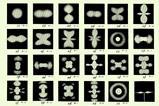Philip Ball reflects on the long-running debate about how colloids stick together
Max Planck’s famous dictum that new theories flourish only when their traditionalist opponents die will surely be in the minds of those who, for the past decade or so, have championed a controversial new theory of colloid science.
In February this year, the last surviving architect of the prevailing theory of colloidal interactions, Theo Overbeek of Utrecht University in The Netherlands, died at the age of 96. Together with his colleague Evert Verwey and the Soviet scientists Lev Landau and Boris Derjaguin, Overbeek devised an explanation for the forces that act between particles of microscopic size, such as silt or red blood cells, when suspended in water. This so-called DLVO theory is generally considered now to provide the basis for understanding a vast range of phenomena of fundamental, industrial and biological importance, from the manufacture of inks and cosmetics to the pollution-retention of clays.
But in the 1980s, two Japanese physicists named Ikuo Sogami and Norio Ise proposed an alternative framework for understanding colloids, which, after years of vigorous debate, still struggles to win wide support. Do its prospects now look any better?
The authors of DLVO theory are a colourful crowd. Landau was one of the most influential and versatile physicists of the twentieth century, contributing important ideas in quantum mechanics, statistical physics and fluid dynamics. Alongside Pyotr Kapitsa and Andrei Sakharov, he courted trouble with his bold criticisms of the Stalinist regime. Derjaguin never fought shy of controversy either: the infamous polywater emerged from his lab in the late 1960s. Landau and Derjaguin worked on the theory of colloidal forces together in the Soviet Union in the 1940s, unaware that Overbeek and Verwey in Utrecht were moving along the same track. When the two duos published their results after the war, a priority dispute broke out that was resolved by rolling all the names together.
DLVO theory says that interactions between colloidal particles, which are typically a micrometre or so in size, are determined by a fine balance of attraction and repulsion. The attraction comes from ubiquitous van der Waals forces, the result of fluctuations in the distribution of surface electrons. Repulsion exists when the surfaces have chemical groups with like electrical charges. The balance of forces determines whether the particles clump together and precipitate, or stay apart in solution. Dissolved salts may shift the balance, which is why silt particles tend to flocculate and turn river water murky in a salty estuary.
Sogami, a particle physicist, constructed a different interpretation of colloidal forces that he developed in collaboration with the experimentalist Ise in Kyoto. Sogami-Ise (SI) theory claims that the attraction between colloidal particles comes from the influence of intervening ions. This gives the attraction a longer reach than in DLVO theory, and also suggests that colloids can avoid aggregating indefinitely. The SI papers went unnoticed in the West until 1987, when Overbeek claimed that the theory was wrong. Most physical chemists considered that the end of the matter, but Martin Smalley at the University of Oxford claimed that only SI, and not DLVO, could explain the swelling behaviour of clays - stacks of charged crystal sheets - when wet. Smalley went to Japan to collaborate with Sogami, Ise and their coworkers in extending the original theory.1
But by the mid-1990s the odds looked stacked against them. In particular, David Grier and John Crocker at the University of Chicago claimed to have clear experimental evidence that only DLVO can account for the forces between colloidal particles.2 Ise was jubilant, however, when Grier’s group later discovered an effect that DLVO could not explain: charged microspheres seem to attract each other over long ranges when they are close to a wall.3
Although Ise claims that SI theory predicts such an attraction, Grier is sticking with DLVO. It is, after all, an approximation that assumes salt ions are smeared out uniformly through the solution. Under some circumstances, that is bound to be an over-simplification. ’Anomalous attractions have only been measured for pairs of spheres near surfaces or crowded by other spheres,’ Grier points out. ’They have never been reported for isolated pairs of spheres, as the SI theory predicts.’
Smalley remains defiantly an SI supporter, a case that he argues with passion in his new book Clay Swelling and Colloid Stability (Taylor & Francis, 2006). Grier is unmoved by his arguments - and one can safely assume that Overbeek would have felt likewise. The debate, however, is surely not over yet.
References
1 T Shinohara et al, Mol. Phys., 2003, 101, 1883 (DOI: 10.1080/0026897031000112442)
2 J C Crocker and D G Grier, Phys. Rev. Lett., 1994, 73, 352 (DOI: 10.1103/PhysRevLett.73.352)
3 A E Larsen and D G Grier, Nature, 1997, 385, 230 (DOI: 10.1038/385230a0)

















No comments yet